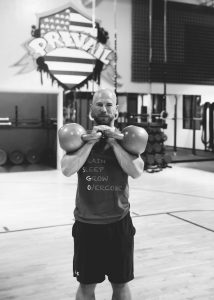Intention
Hey all. I’m currently in Paris, getting set to go meet up with Lindsay’s cousin who happens to live here, and spend a few more days touring museums and art exhibits like I have some sort of culture.
That or asking everyone in French if they even lift. After seeing most people here, no. No they don’t.
With that being said, I don’t want to do work, so I put out a call for guest submissions for the site, and today I have a solid one from Sean Shearon of Prevail Strength & Fitness.
*****
Intention is the most undervalued piece in the progress puzzle. As we grow and learn the process of progression, there are steps, rules and guidelines that help us lay out our plan. We can implement action to move us in the proper direction. Sometimes these systems are bare bones in their simplicity or can be extremely complex, cyclical programs, which will vary from goal to goal and client to client.
Now, I am coming from a Fitness and Nutrition bias, but this psychology can be applied to anything from building a doghouse, to getting out of debt or even to repairing a damaged relationship (with someone else or yourself). You’re probably thinking, “Oh goodness, Sean is going deep with this one!” and my response to that is, “That’s what she said.” Haha, no but seriously the topic of intention is rarely talked about, but it is a critical element to success.
Let’s kick off with a cliché writing moment wherein I define intention:
- a determination to act in a certain way
- a concept considered as the product of attention directed to an object of knowledge
(via Webster’s)
Why don’t we take a moment to dissect these definitions and explain how they apply to movement.
“A determination to act in a certain way.”
What I generally see in most people is “to act in a way.” Great! So, you’ve made the decision to [insert goal here]. Congrats, that’s awesome, you are further along than most people. (However, I know this audience is likely already in the small % of people who actually take action, give yourself a high five, either in a mirror or just high five your other hand, it doesn’t matter to me.) Back to “to act in a way.” So, now what? You go to the gym and you’ve told yourself, “I’m going to eat better.” Fantastic, you are acting in some sort of way but that’s only halfway there. Don’t get me wrong; you’ll see progress but it’s unlikely that you will reach or exceed your goal. So, where does the last 10% come from? How do you go beyond expectations and crush barriers of growth?
Let’s now refer to the 2nd part of the definition:
“A concept considered as the product of attention directed to an object of knowledge.”
We need to treat intention as a concept, a method and a priority. If intention is the product of attention directed then we sure as hell better give attention to our direction. We have to know our direction and not become lazy or misguided with that specific attention. For example, baking a cake. There’s directions we can half-ass, there’s ingredients that may or may not matter. Then cook it at an unknown temperature and sloppily cover it with icing. TA DA! You have a super shitty cake but, damn it, you have a cake. I hope I don’t have to explain this metaphor but I myself like really good cake, like the stuff your great aunt Myrtle makes (you know that aunt you rarely talk to unless you’re complimenting her cake while most likely stuffing your face with said cake). You better believe that aunt gives great attention to the directions (even if they are her own that she won’t share with you).
So, the first step toward implementing intention is to exercise great care and enthusiasm in the attention to detail. Attention to detail was almost literally hammered into my brain dome during my 5 years in the blessed Marine Corps. And let me tell you, those guys know a few things about executing missions, so they might just be on to something. (It’s not like they are the world’s best fighting force or anything.)
Where were we? Oh yeah, “determination to act in a certain way.” How do we add determination and certainty back into the equation? I’m going to use exercise and more specifically movement as an example. If we have a movement like a get-up, deadlift or even something as simple as a bicep curl, you can understand the objective of the exercise: stand up with the bell, pick the bar off the ground, or curl the weight. When we add intention to the mix, you will be able to lift considerable more weight giving you better results. However, you can lift considerable less weight but with even greater result (dependent on goal).
Stay with me. A bicep curl is by far the most commonly abused exercise in the gym. We know the goal of the bicep curl is to take two levers (upper arm and lower arm) and hinge them at an axis (elbow) until the two arms are in line with each other (180*). We flex (concentric) the bicep in order to make this action happen. This is the simplest explanation for the bicep curl. Let’s look at a couple of different curls with varying intentions.
Version 1. Bob (or Sue) takes a random weight at an unknown rep/set scheme and flings his hands through the air and by some sort of magic the bicep curl happens. The dumbbell has no distinct flight and the rest of the body moves uncontrollably as if in some sort of strange drug-like euphoria during an earthquake. That’s an example of 0 intention, just action. (Let’s face it, the real dumbbell here, is Bob.)
Version 2. Bob now has an appropriate weight and has been guided by a professional as to how to properly perform a bicep curl. (Sue is not around because she hurt her elbow and is now on the elliptical creeping on Instagram.) But, since Bob can’t stop staring at Sue on the elliptical, he has no focus or intensity in his action; he now has half-ass intention.
Version 3. This is it! This is the good stuff, this is where magic happens, this is when progress begins, AND this is also when the real work starts. Bob has been scolded by his trainer to pay attention and grow the balls to flirt with Sue post-workout. Bob also has been instructed to move with intention and concentrate on every possible aspect of the exercise. Bob applies all of his intensity to every rep at 100%. His breathing is on point, he’s thinking of nothing but crushing the dumbbell and dreaming of his future awesome arms. This is REAL intention. Bob now has confidence and gets Sue’s number after teaching her the same lesson in intention.
Life is full of opportunities to implement intention. Wake up in the morning with the intention of making people smile; now take action with direction and attention to the concept of bringing joy. Go for a walk with the intention of relaxation; walk with no worries and easy breathing while clearing your mind. Go to the gym without the chore of movement, or lax vision of just getting through the workout. Pick up the damn bar with intention, swing the bell with intention and even cool down with intention.
Take a moment and think about the three different versions of Bob’s actions. Which Bob (or Sue) are you?
About the Author
Sean Shearon spent 5 years in the United States Marine Corps as a Aircraft firefighter, after that has been training for 6 years moving from outdoor bootcamps to personal trading and now specialize in small group strength training. He’s studied kinesiology at the University of Central Oklahoma and holds several certifications ranging from Titliest performance level 1 to Muscle Activation Techniques. For more information on Sean, check him out at Prevail Strength and Fitness.

